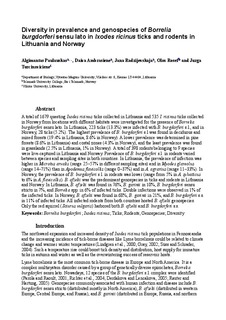| dc.description.abstract | A total of 1679 questing Ixodes ricinus ticks collected in Lithuania and 535 I. ricinus ticks collected in Norway from locations with different habitats were investigated for the presence of Borrelia burgdorferi sensu lato. In Lithuania, 223 ticks (13.3%) were infected with B. burgdorferi s.l., and in Norway, 28 ticks (5.2%). The highest prevalence of B. burgdorferi s.l was found in deciduous and mixed forests (19.4% in Lithuania, 8.6% in Norway). A lower prevalence was determined in pine forests (8.6% in Lithuania) and costal zones (4.3% in Norway), and the least prevalence was found in grasslands (2.5% in Lithuania, 1% in Norway). A total of 398 rodents belonging to 9 species were live-captured in Lithuania and Norway. Prevalence of B. burgdorferi s.l. in rodents varied between species and sampling sites in both countries. In Lithuania, the prevalence of infection was higher in Microtus arvalis (range 25??7% in different sampling sites) and in Myodes glareolus (range 14??1%) than in Apodemus flavicollis (range 0??7%) and in A. agrarius (range 11??3%). In Norway, the prevalence of B. burgdorferi s.l. in rodents was lower (range from 5% in A. sylvaticus to 6% in A. flavicollis). B. afzelii was the predominant genospecies in ticks and rodents in Lithuania and Norway. In Lithuania, B. afzelii was found in 76%, B. garinii in 10%, B. burgdorferi sensu stricto in 7%, and Borrelia spp. in 6% of infected ticks. Double infections were observed in 1% of the infected ticks. In Norway, B. afzelii was found in 68%, B. garinii in 21%, and B. burgdorferi s.s. in 11% of infected ticks. All infected rodents from both countries hosted B. afzelii genospecies. Only the red squirrel (Sciurus vulgaris) harbored both B. afzelii and B. burgdorferi s.s. | |
